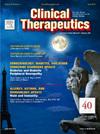Efficacy and Safety of Nintedanib in Japanese Patients With Early-Stage Idiopathic Pulmonary Fibrosis: A One-Year Interim Analysis from a Multicenter Observational Study in Kyushu and Okinawa, Japan
IF 3.6
4区 医学
Q2 PHARMACOLOGY & PHARMACY
引用次数: 0
Abstract
Background
Idiopathic pulmonary fibrosis (IPF) is a chronic, progressive lung disease with a poor prognosis. Nintedanib, an antifibrotic agent, has been shown in clinical trials to slow the decline in forced vital capacity (FVC) and reduce acute exacerbations (AE-IPF). Long-term studies confirm its continued effectiveness, though side effects like diarrhea may affect adherence. Despite real-world data supporting nintedanib’s benefits, no prospective study has assessed its efficacy in early-stage IPF. This study evaluated the efficacy, safety, and tolerability of nintedanib in patients with early-stage IPF to assess its effectiveness outside randomized control trials.
Methods
A 1-year interim analysis of a prospective, multicenter observational study was conducted in Kyushu and Okinawa, Japan. This study included 215 patients with early-stage IPF (stage I/II per the Japanese IPF severity system) who were followed up for 52 weeks. Changes in FVC and diffusion capacity of carbon monoxide (DLco); incidence of adverse events, acute exacerbations, and death; and factors associated with FVC decline and nintedanib discontinuation were evaluated.
Results
The percentage of predicted FVC (%FVC) remained stable, from 83.2% at baseline to 83.7% at 52 weeks, while %DLco decreased from 70.8% to 64.2%. Incidences of acute exacerbation and death were both 4.7%. Nintedanib was discontinued due to adverse events in 21.9% of the patients. Risk factors for FVC decline (>5%) included female sex, GAP stage II/III, low oxygen saturation (SpO2) in the 6-minute walk test (6 MWT), and elevated biomarkers (KL-6). Significant factors for nintedanib discontinuation were advanced age, modified Medical Research Council (mMRC) grade I or higher, GAP stage II/III, low %FVC, low SpO2 in the 6 MWT, short 6 MWT distance, and low albumin levels.
Conclusion
The findings of this interim analysis indicate that nintedanib has good efficacy, safety, and tolerability for early-stage IPF in real-world settings, outside randomized control trials.
尼达尼布在日本早期特发性肺纤维化患者中的疗效和安全性:来自日本九州和冲绳的一项多中心观察性研究的一年中期分析。
背景:特发性肺纤维化(IPF)是一种慢性进行性肺部疾病,预后较差。尼达尼布(Nintedanib)是一种抗纤维化药物,已在临床试验中显示出减缓用力肺活量(FVC)下降和减少急性加重(AE-IPF)的作用。长期研究证实其持续有效,尽管腹泻等副作用可能会影响坚持服用。尽管实际数据支持nintedanib的益处,但没有前瞻性研究评估其对早期IPF的疗效。本研究评估了尼达尼布在早期IPF患者中的有效性、安全性和耐受性,以评估其在随机对照试验之外的有效性。方法:在日本九州和冲绳进行了一项为期1年的前瞻性多中心观察性研究的中期分析。该研究包括215例早期IPF患者(按日本IPF严重程度系统分为I/II期),随访52周。植被覆盖度和一氧化碳扩散能力的变化;不良事件、急性恶化和死亡的发生率;评估与植被覆盖度下降和尼达尼布停药相关的因素。结果:预测FVC百分比(%FVC)保持稳定,从基线时的83.2%降至52周时的83.7%,而%DLco从70.8%降至64.2%。急性加重和死亡发生率均为4.7%。21.9%的患者因不良事件停用尼达尼布。FVC下降的危险因素包括女性、GAP II/III期、6分钟步行测试(6 MWT)低氧饱和度(SpO2)和生物标志物(KL-6)升高。尼达尼布停药的重要因素是高龄、改良医学研究委员会(mMRC) I级或更高、GAP II/III期、低FVC %、6 MWT低SpO2、6 MWT距离短和低白蛋白水平。结论:该中期分析结果表明,在随机对照试验之外,尼达尼布在现实环境中对早期IPF具有良好的疗效、安全性和耐受性。
本文章由计算机程序翻译,如有差异,请以英文原文为准。
求助全文
约1分钟内获得全文
求助全文
来源期刊

Clinical therapeutics
医学-药学
CiteScore
6.00
自引率
3.10%
发文量
154
审稿时长
9 weeks
期刊介绍:
Clinical Therapeutics provides peer-reviewed, rapid publication of recent developments in drug and other therapies as well as in diagnostics, pharmacoeconomics, health policy, treatment outcomes, and innovations in drug and biologics research. In addition Clinical Therapeutics features updates on specific topics collated by expert Topic Editors. Clinical Therapeutics is read by a large international audience of scientists and clinicians in a variety of research, academic, and clinical practice settings. Articles are indexed by all major biomedical abstracting databases.
 求助内容:
求助内容: 应助结果提醒方式:
应助结果提醒方式:


